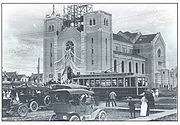.gif)
Holy Rosary Cathedral (Regina)
Encyclopedia

Rosary
The rosary or "garland of roses" is a traditional Catholic devotion. The term denotes the prayer beads used to count the series of prayers that make up the rosary...
Cathedral at 13th Avenue and Garnet Street in Regina, Saskatchewan
Regina, Saskatchewan
Regina is the capital city of the Canadian province of Saskatchewan. The city is the second-largest in the province and a cultural and commercial centre for southern Saskatchewan. It is governed by Regina City Council. Regina is the cathedral city of the Roman Catholic and Romanian Orthodox...
, is the cathedral church of the Roman Catholic
Catholic
The word catholic comes from the Greek phrase , meaning "on the whole," "according to the whole" or "in general", and is a combination of the Greek words meaning "about" and meaning "whole"...
Archdiocese of Regina. Its construction began in 1912; the cornerstone was blessed by the Papal Ambassador on June 29, 1913.
It was designed in the Romanesque Revival style by the firm of Joseph Fortin of Montreal, who also designed the Roman Catholic cathedrals in Saskatoon and Gravelbourg. Smith Bros. & Wilson built it at a cost of $200,000.
The building was designed by the Montréal architect J. Fortin and modelled after churches in northern France; it was built by Smith Brothers & Wilson at a cost of $135,000. The cornerstone was blessed (see photo) by the Apostolic Delegate — the Ambassador of the Holy See — on 30 June 1913 before some 2000 people and the building was completed in 1917.
Redecorations
The interior of the church has been extensively redecorated five times:- 1928
- 1951 - 43 stained glass windows by André Rault were installed
- 1968 - a more fundamental renovation to conform with the directives of the Second Vatican CouncilSecond Vatican CouncilThe Second Vatican Council addressed relations between the Roman Catholic Church and the modern world. It was the twenty-first Ecumenical Council of the Catholic Church and the second to be held at St. Peter's Basilica in the Vatican. It opened under Pope John XXIII on 11 October 1962 and closed...
, when the high altar at the east end of the choir was dismantled and a nave altar installed at the crossingCrossing (architecture)A crossing, in ecclesiastical architecture, is the junction of the four arms of a cruciform church.In a typically oriented church , the crossing gives access to the nave on the west, the transept arms on the north and south, and the choir on the east.The crossing is sometimes surmounted by a tower...
, the choir being converted into a chapel - 1976 - after a disastrous fire. During the months following the 1976 fire the Cathedral was unusable and massMassMass can be defined as a quantitive measure of the resistance an object has to change in its velocity.In physics, mass commonly refers to any of the following three properties of matter, which have been shown experimentally to be equivalent:...
es were held in the neighbouring Westminster United Church. - 1992 - the opaque screen separating the nave from the choir was removed and the main altar restored to a position in the choir closer to the site of the original high altar in the former sanctuary
The light and airy interior of the cathedral is decorated sparingly in keeping with Canadian aesthetic sensibilities.
The Institute for stained glass in Canada has documented the stained glass at Holy Rosary Cathedral.
Organs
The McGuigan Organ in the gallery was originally built in 1930, replacing a large reed organ, extensively repaired after the 1976 fire, and renovated in 1992–1993 and renamed "The McGuigan Organ" in honour of Sister Marion McGuigan, a much loved local humanitarian and educator. It was built by Casavant FrèresCasavant Frères
Casavant Frères is a prominent Canadian company in Saint-Hyacinthe, Quebec, which has been building fine pipe organs since 1879. As of 2008, they have produced over 3800 organs.- Company history :...
of Saint-Hyacinthe, Quebec
Saint-Hyacinthe, Quebec
Saint-Hyacinthe is a city in southwestern Quebec east of Montreal on the Yamaska River. The population as of the Canada 2006 Census was 55,823. The city is located in Les Maskoutains Regional County Municipality of the Montérégie region, and is traversed by the Yamaska River which flows...
.
Sacred Heart Academy

The building has now been converted to strata title and sold off as tony townhouses, but the Roman Catholic Archdiocese has retained premises in the building for its synod office.
Social issues

As the Cathedral has in recent years found itself required to be locked and barred to entry other than at regularly scheduled service times, the synod office, as perhaps an unfortunate sign of the times, warns off seekers of charity, suggesting that they consult the Salvation Army.
During the 1960s through '90s relations with neighbouring Anglican and United Church parishes were extremely warm: note above as to masses having been held at Westminster United Church next door when the Cathedral was unusable after a fire. Vatican directives have more recently discouraged such co-operation and the Cathedral now posts commissionaires to keep non-Roman Catholics away.

